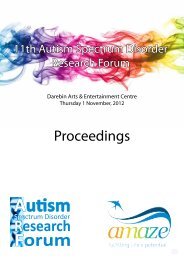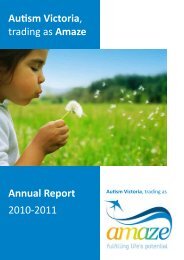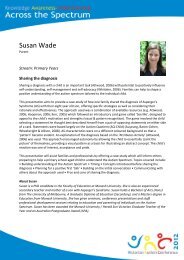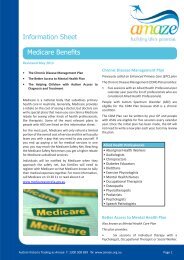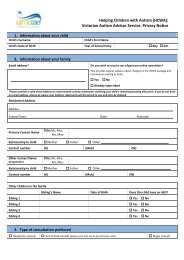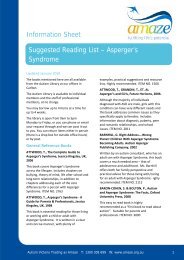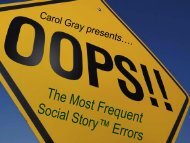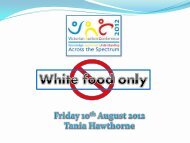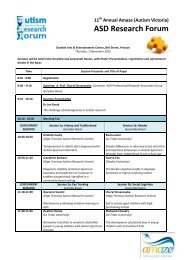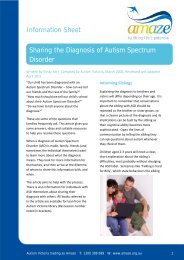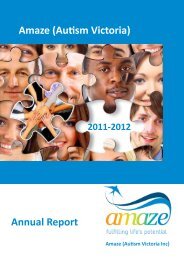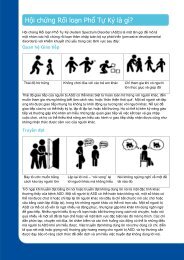Relationships and sexuality within High Functioning ... - Amaze
Relationships and sexuality within High Functioning ... - Amaze
Relationships and sexuality within High Functioning ... - Amaze
Create successful ePaper yourself
Turn your PDF publications into a flip-book with our unique Google optimized e-Paper software.
© 2012 Dr Mark Stokes<br />
Background<br />
• Current knowledge of the <strong>sexuality</strong> in autism is limited<br />
– Persons with autism are regarded as sexually immature<br />
– Some think having a social deficit renders you <strong>sexuality</strong> irrelevant<br />
– (Konstantareas & Lunsky, 1997)<br />
• Adolescents with ASD have more difficulty forming relationships<br />
than Conduct Disordered adolescents<br />
– Green, Gilchrist, Burton & Cox (2000)<br />
• Many individuals with autism are interested in marriage <strong>and</strong> sexual<br />
relationships but lack experience & knowledge<br />
– (Newport & Newport, 2002 ; Ousley & Mesibov, 1991; Henault & Attwood, 2006)<br />
• Previous research has found that individuals with autism may<br />
display inappropriate sexual behaviour<br />
– (Haracopos & Pedersen, 1992 ; Hellemans & Deboutte, 2002; Ruble & Dalrymple, 1993)<br />
– Undertaken using mixed samples of low <strong>and</strong> high functioning
© 2012 Dr Mark Stokes<br />
Aberrant behaviour in Clinical Literature<br />
• Aberrant behaviours found with younger adult or adolescent<br />
males inappropriately pursuing females in search of relationships<br />
– (Clarke et al., 1999; Green et al., 2000; Howlin, 1997; Smith-Myles & Simpson 2002; Murrie et al., 2002)<br />
– Pursuing even when threatened with assault by others<br />
– (Howlin, 1997)<br />
– Following <strong>and</strong> touching strangers<br />
– (Clements & Zarkowska, 2002)<br />
– Undressing <strong>and</strong> masturbating in public<br />
– (Haracopos & Pedersen, 1992; Ruble & Dalrymple, 1993)<br />
– Genital exposure<br />
– (Howlin, 1997)<br />
– Kissing of strangers<br />
– (Clements & Zarowska, 2000)<br />
– Kidnap <strong>and</strong> bondage<br />
– (Murrie et al., 2002)<br />
– Attempted strangulation of the victim<br />
– (Howlin, 1997)
How do adults & adolescents with<br />
autism develop <strong>sexuality</strong> with Kaur<br />
• Stokes & Kaur (2005)<br />
• Social Behaviour, Sexual Behaviour, Privacy, Sex<br />
Education, Parental Concerns<br />
• Parental response scale<br />
Scale Items Reliability<br />
Social Contact 22 0.91<br />
Social Insight 8 0.89<br />
Sexual Behaviour (mod) 6 0.62<br />
Parental Concerns 10 0.94<br />
• Parents of:<br />
– 50 TD adolescents &<br />
– 23 adolescents with HF ASD<br />
© 2012 Dr Mark Stokes
© 2012 Dr Mark Stokes<br />
1<br />
0.9<br />
0.8<br />
Social Behaviour<br />
Difference in slopes: t= 2.54, p< 0.01<br />
©1<br />
ASD<br />
Typical<br />
Linear (HF ASD)<br />
Linear (TD)<br />
Score<br />
0.7<br />
0.6<br />
0.5<br />
0.4<br />
0.3<br />
0.2<br />
0.1<br />
0<br />
10 11 12 13 14 15 16<br />
Age
© 2012 Dr Mark Stokes<br />
1<br />
0.9<br />
Problematic Sexual Behaviours<br />
Difference in Slope: t=-1.70, p=0.09 ©1<br />
Scale Score<br />
0.8<br />
0.7<br />
0.6<br />
0.5<br />
0.4<br />
0.3<br />
0.2<br />
0.1<br />
0<br />
10 11 12 13 14 15 16<br />
Age
© 2012 Dr Mark Stokes<br />
Privacy<br />
ASD<br />
Typical<br />
Linear (HF ASD)<br />
Linear (TD)<br />
Score<br />
1<br />
0.9<br />
0.8<br />
0.7<br />
0.6<br />
0.5<br />
0.4<br />
0.3<br />
0.2<br />
*<br />
0.1<br />
0<br />
Difference in slopes: t= -0.94, p= 0.35<br />
10 11 12 13 14 15 16<br />
Age
Parental Concerns<br />
© 2012 Dr Mark Stokes<br />
1<br />
0.9<br />
0.8<br />
0.7<br />
Difference in slopes: t= -2.77, p
© 2012 Dr Mark Stokes<br />
Are behaviours seen in adolescents <strong>and</strong> adults<br />
with autism consistent across culture with Kaur<br />
• Kaur & Stokes (2011 submitted); Kaur (2009)<br />
• Cross cultural study to estimate the effect of<br />
culture in social & sexual behaviour<br />
• Parental Survey of children 10 to 20 years<br />
(M=14.87)<br />
• Sexual Behaviour Scale – II<br />
TD HFA DS Total<br />
Australia 55 32 42 129<br />
India 58 26 36 120<br />
Singapore 40 8 33 81<br />
Total 153 66 111 330
© 2012 Dr Mark Stokes<br />
4<br />
Social contact<br />
4<br />
Social insight<br />
3.5<br />
3.5<br />
3<br />
3<br />
2.5<br />
2<br />
1.5<br />
1<br />
Australia<br />
India<br />
Singapore<br />
2.5<br />
2<br />
1.5<br />
1<br />
Australia<br />
India<br />
Singapore<br />
0.5<br />
0.5<br />
0<br />
TD HFA DS<br />
0<br />
TD HFA DS<br />
1.6<br />
Problematic Sexual behaviour<br />
4<br />
Parental concerns<br />
1.4<br />
3.5<br />
1.2<br />
3<br />
1<br />
0.8<br />
0.6<br />
0.4<br />
Australia<br />
India<br />
Singapore<br />
2.5<br />
2<br />
1.5<br />
1<br />
Australia<br />
India<br />
Singapore<br />
0.2<br />
0.5<br />
0<br />
TD HFA DS<br />
0<br />
TD HFA DS<br />
• Country by Condition interaction reveals Social Insight & Parental Concerns<br />
responded to differently in each country<br />
• (conditions are not seen consistently across culture)<br />
• Suggests Social Insight interventions may be effective<br />
– Sexual Behaviour or Social Contact had no interaction because differences over Country<br />
relatively small<br />
• Sexual Behaviour over Country was the only effect that was NOT significant<br />
• Michelle Garcia Winner – www.socialthinking.com (Speech Therapist)
© 2012 Dr Mark Stokes<br />
Do persons with HFA have insight into<br />
their behaviour with Mehzabin<br />
• MEHZABIN, P. & STOKES, M.A. (2011).<br />
• SBS-II was used modified for adolescents<br />
• Young adults 18 to 30 years<br />
• 46 TD, 24 HFA responses<br />
1<br />
0.8<br />
0.6<br />
HFA<br />
TD<br />
0.4<br />
0.2<br />
0<br />
Social<br />
Behaviour<br />
Privacy<br />
Sex<br />
Education<br />
Sexualised<br />
Behaviour<br />
Sexual<br />
Experience<br />
Future<br />
Concerns
© 2012 Dr Mark Stokes<br />
How do adolescents with ASD develop<br />
relationships with Newton & Kaur<br />
• STOKES, M.A.., NEWTON, N., & KAUR., A. (2007)<br />
• Parental survey of 25 ASD, 38 TD<br />
• Aged 13 – 36 (2 cases 30+ not different so included)<br />
A<br />
1<br />
B<br />
1<br />
0.8<br />
0.8<br />
Social Function<br />
0.6<br />
0.4<br />
Romantic Function<br />
0.6<br />
0.4<br />
TD<br />
0.2<br />
0.2<br />
ASD<br />
0<br />
10 15 20 25 30 35 40<br />
Age<br />
0<br />
10 15 20 25 30 35 40<br />
Age
© 2012 Dr Mark Stokes<br />
What are the sources of learning for social &<br />
romantic function with Newton & Kaur<br />
• Social function: TD adolescents & adults learn<br />
– most from their PEERS & OBSERVATION, <strong>and</strong><br />
– least from their PARENTS<br />
• Romantic function: TD adolescents & adults learn<br />
– most from their PEERS & SOCIAL FUNCTION, <strong>and</strong><br />
– least from their PARENTS & SIBLINGS<br />
0.2<br />
0.1<br />
0<br />
-0.1<br />
-0.2<br />
-0.3<br />
Social Function<br />
TD sr<br />
ASD s r<br />
Romantic Function<br />
0.8<br />
TD sr<br />
0.6<br />
ASD sr<br />
0.4<br />
0.2<br />
0<br />
-0.2<br />
-0.4<br />
Parents<br />
Media<br />
Sex Education<br />
Sibling<br />
Peers<br />
Observation<br />
Siblings<br />
Parents<br />
Media<br />
Observation<br />
Social Function<br />
Sex Education<br />
Peers
© 2012 Dr Mark Stokes<br />
What are the sources of learning for social &<br />
romantic function with Newton & Kaur<br />
• Social function: adolescents & adults with ASD learn<br />
– most from their PEERS, SIBLINGS, & SEX ED, <strong>and</strong><br />
– least from the MEDIA<br />
• Romantic function: adolescents & adults with ASD learn<br />
– most from their SOCIAL FUNCTION, PARENTS, & OBSERVATION, <strong>and</strong><br />
– least from their PEERS, SEX ED, & SIBLINGS<br />
0.2<br />
0.1<br />
0<br />
-0.1<br />
-0.2<br />
-0.3<br />
Social Function<br />
TD sr<br />
ASD s r<br />
Romantic Function<br />
0.8<br />
TD sr<br />
0.6<br />
ASD sr<br />
0.4<br />
0.2<br />
0<br />
-0.2<br />
-0.4<br />
Parents<br />
Media<br />
Sex Education<br />
Sibling<br />
Peers<br />
Observation<br />
Siblings<br />
Parents<br />
Media<br />
Observation<br />
Social Function<br />
Sex Education<br />
Peers
© 2012 Dr Mark Stokes<br />
Relationship Initiation<br />
• Relationship initiation involves behaviours such as:<br />
– Ask person out on a date<br />
– Telephone or send them letters<br />
– Wait for them outside work or<br />
– Make other attempts to initiate social contact<br />
• Subtle distinction between appropriate <strong>and</strong> inappropriate<br />
behaviours<br />
• If attention is unwanted persistence is typically described as<br />
harassment or stalking
© 2012 Dr Mark Stokes<br />
Many adolescents & adults with HFA:<br />
– Have experienced considerable social<br />
rejection <strong>and</strong> exclusion<br />
– DON’T LEARN to read normal social<br />
conventions<br />
– DO LEARN that associations with others<br />
available with persistence
© 2012 Dr Mark Stokes<br />
Do adults & adolescents with HFA persist<br />
unduly with Newton & Kaur<br />
• Persist significantly<br />
longer than TD<br />
• Negative responses<br />
have less effect on<br />
persons with HFA<br />
than TDs<br />
Duration of persistance (days)<br />
21<br />
14<br />
7<br />
0<br />
No response<br />
Negative<br />
response<br />
Negative<br />
response from<br />
person's family<br />
or friends<br />
TD<br />
HFA
© 2012 Dr Mark Stokes<br />
Why do persons with HFA persist in the face<br />
of such negative responses with Broadbent<br />
• Broadbent & Stokes (2012); Broadbent (2012)<br />
• HFA N=50, TD N=50.<br />
• Wisconsin Card Sort Task (WCST)<br />
– Four suits (crosses, circles, triangles, stars), four colours<br />
(red, yellow, blue, green), & four symbols (#1, 2, 3, & 4)<br />
• Two groups: Traditional WCST; Modified WCST<br />
– Traditional WCST participants receive positive <strong>and</strong> negative<br />
feedback<br />
– Modified WCST participants receive only positive feedback
© 2012 Dr Mark Stokes<br />
Why do persons with HFA persist in the face<br />
of such negative responses with Broadbent<br />
• Individuals with HFA get more correct responses when they<br />
don’t get negative feedback<br />
Correct Responses<br />
80<br />
78<br />
76<br />
74<br />
72<br />
70<br />
68<br />
66<br />
64<br />
62<br />
60<br />
Traditional WCST<br />
Modified WCST<br />
HFA<br />
TD
© 2012 Dr Mark Stokes<br />
Why do persons with HFA persist in the face<br />
of such negative responses with Broadbent<br />
• These result suggest persons with an ASD<br />
– Do not respond when they have negative<br />
information guiding them<br />
– Need positive information <strong>and</strong> alternate strategies
© 2012 Dr Mark Stokes<br />
How important is it to underst<strong>and</strong> the mood & intent of<br />
others in establishing a relationship with de Quadros-W<strong>and</strong>er<br />
• de QUADROS-WANDER, S. & STOKES, M.A. (2007)<br />
• 30 females <strong>and</strong> 30 males undergraduates<br />
• Induced positive & negative moods using film<br />
• Asked about sexual intent or commitment intent in response to a<br />
situation description
© 2012 Dr Mark Stokes<br />
How important is it to underst<strong>and</strong> the mood & intent of<br />
others in establishing a relationship with de Quadros-W<strong>and</strong>er<br />
• Positive mood shift female increases female sexual intent<br />
• Negative mood shift doesn’t adjust sexual or commitment intent<br />
• Positive mood shift<br />
– Females raise own sexual<br />
intent<br />
– Males estimated higher female<br />
sexual intent<br />
• Same was NOT found for male<br />
commitment intent<br />
Rating<br />
1.8<br />
1.6<br />
1.4<br />
1.2<br />
1<br />
0.8<br />
0.6<br />
0.4<br />
0.2<br />
0<br />
Female Self<br />
Male assess female<br />
Female assess female<br />
Positive<br />
Mood<br />
Negative<br />
Mood<br />
Negative<br />
Mood<br />
Positive<br />
Mood<br />
PN Mood shift<br />
NP Mood shift
© 2012 Dr Mark Stokes<br />
What behaviours do adults & adolescents with HFA<br />
use to initiate romantic relationships with Newton & Kaur<br />
• HFA is 9 times more<br />
likely to act<br />
inappropriately than TD<br />
• Appropriate behaviour<br />
• TD 90%<br />
• HFA 51%<br />
• Inappropriate<br />
behaviour<br />
• TD 10%<br />
• HFA 49%<br />
• HFA as likely to<br />
damage property as to<br />
ask on a date, write a<br />
letter, or give a gift<br />
Telephone<br />
Attempt to initiate social contact<br />
Asked out on a date<br />
Letters or email<br />
Waited for them<br />
Made contact with family<br />
Shown exagerrated affection<br />
Gifts<br />
Fantasised about them<br />
Touched inappropriately<br />
Believed target reciprocated their feelings<br />
Made inappropriate comments<br />
Monitored their activities<br />
Followed them<br />
Persued in threatening manner<br />
Shown obsessional interest<br />
Made threats<br />
Threatened to hurt self<br />
Made inappropriate gestures<br />
Stolen or damaged their property<br />
Relative probability<br />
- 0.05 0.10 0.15 0.20 0.25<br />
TD<br />
HFA
© 2012 Dr Mark Stokes<br />
How do people with HF ASD go dealing with<br />
initial attraction & presentation With Galic<br />
• Dressing when going to a Birthday Party<br />
• 10 to 15 y/o
© 2012 Dr Mark Stokes<br />
How do people with HF ASD go dealing with<br />
initial attraction & presentation With Galic<br />
• Dressing when going to a Birthday Party<br />
• 10 to 15 y/o
What is important in initial attraction for<br />
persons with HF ASD With Goldsworthy<br />
• Goldsworthy (2010); Goldsworthy & Stokes (2011 in preparation)<br />
• N=94 (21 M & 73 F) (17 HF ASD, 76 TD partners of people with HF ASD)<br />
© 2012 Dr Mark Stokes<br />
TD Female Partners Preferences<br />
• Resources accounts for<br />
32% of variance<br />
• TD females with a partner<br />
who has an ASD rated the<br />
resources factor as more<br />
important for initial<br />
attraction than TD<br />
females with a TD partner
What is important in initial attraction for<br />
persons with HF ASD With Goldsworthy<br />
© 2012 Dr Mark Stokes<br />
Males Preferences<br />
Item 67 ‘The person was or is yielding.’ 31% of variance<br />
Item 93 ‘The person made/makes decisions easily.’ 27 % of variance
• Ponnampalam (2010); Ponnampalam & Stokes (2011).<br />
• Trade-offs <strong>and</strong> Implicit Preferences in Human<br />
Mate Selection<br />
• 148 men, 186 women<br />
• Conjoint design<br />
© 2012 Dr Mark Stokes<br />
What do TD persons value in long term<br />
relationships with Ponnampalam
© 2012 Dr Mark Stokes<br />
What do TD persons value in long term<br />
relationships with Ponnampalam<br />
30<br />
H2 F>M H3 M>F H4 F>M H5 F>M H6 F older M<br />
Location score of choice<br />
25<br />
20<br />
15<br />
10<br />
5<br />
M<br />
F<br />
0<br />
Partner<br />
Warmth<br />
Physical<br />
Attraction<br />
Sexiness<br />
Future<br />
Earning<br />
Potential<br />
Ambition<br />
Desire to<br />
have<br />
Children<br />
Relative Age
N=75 persons with ASD, <strong>and</strong> 137 TD<br />
Attractiveness Resources Security<br />
© 2012 Dr Mark Stokes<br />
What will TD partners trade off for their long term<br />
partner with ASD With Goldsworthy
© 2012 Dr Mark Stokes<br />
What will TD partners trade off for their long term<br />
partner with ASD With Goldsworthy<br />
Security Emotional Resources
© 2012 Dr Mark Stokes<br />
Where do persons with ASD find partners<br />
With Goldsworthy<br />
• Goldsworthy (2010); Goldsworthy & Stokes (2011 in preparation)<br />
• 75 persons with ASD, <strong>and</strong> 137 TD<br />
• 56% married (mean: 13.75 yrs), rest in long term relationships<br />
25<br />
20<br />
Frequency<br />
%<br />
15<br />
10<br />
TD<br />
ASD<br />
5<br />
0<br />
Friend Internet Work School Bar/Nightclub Family Dating<br />
agency
© 2012 Dr Mark Stokes<br />
Do persons with an ASD see themselves<br />
as good potential mates with Goldsworthy
© 2012 Dr Mark Stokes<br />
Summary<br />
• Persons with an ASD<br />
– Have normal sexual desires<br />
– Lack of awareness of critical issues involved in this, such as<br />
privacy<br />
– Show different levels of Social insight in different countries,<br />
<strong>and</strong> thus this may be developed<br />
– Show development in Romantic Skills with increasing age<br />
– Learn Social Function from peers <strong>and</strong> siblings<br />
– Learn Romantic skills from Social Skills, Parents, Observation<br />
& Media<br />
– Have insight into their difficulties
© 2012 Dr Mark Stokes<br />
Summary<br />
• Persons with an ASD<br />
– Have little underst<strong>and</strong>ing of how to develop a relationship<br />
appropriately<br />
– Do not know how to dress appropriately<br />
– Will frequently use inappropriate strategies to pursue a<br />
relationship<br />
– Will persist inappropriately with persons of romantic<br />
interest<br />
– Will need to be assisted by being offered alternative<br />
strategies rather than persistence<br />
– When rebutted by a romantic target will need to be guided<br />
positively about this<br />
– May need coaching in judging a romantic target’s mood <strong>and</strong><br />
intent
© 2012 Dr Mark Stokes<br />
Summary<br />
• Persons with an ASD<br />
– When they do develop a relationship it is generally<br />
through family or the internet<br />
– Suggesting organised social structures may be<br />
useful in helping develop relationships<br />
– However, when obtained, relationships are sought<br />
with persons with an ASD because they offer:<br />
• Attractiveness<br />
• Resources<br />
• Security
© 2012 Dr Mark Stokes<br />
Summary<br />
• TD persons attracted to partner with an ASD sought<br />
– Attractiveness, Resources, & Security,<br />
– But will seek social skills over emotional skills<br />
– Want their needs supported (selfish orientation)<br />
• Thus we enhance the romantic potential of persons with ASD by<br />
–Teaching positive strategies around relationship development<br />
–Improving social skills<br />
–Providing formal structures for social opportunities
© 2012 Dr Mark Stokes<br />
References<br />
• BROADBENT, J. & STOKES M.A. (2011). Perseveration in Autistic Spectrum Disorders; the role of negative<br />
feedback. IMFAR 2011, May 12-14, 2011, San Diego, California.<br />
• CLARKE, D., BAXTER, M., PERRY, D.& PRASHER, V. (1999). The Diagnosis of Affective <strong>and</strong> Psychotic<br />
Disorders in Adults with Autism: Seven Case Reports, Autism 3 (2): 149–64.<br />
• CLEMENTS, J .& ZARKOWSKA, E . (2002) Behavioural Concerns <strong>and</strong> Autistic Spectrum Disorder:<br />
Explanations <strong>and</strong> Strategies for Change. London, UK: Jessica Kingsley.<br />
• de QUADROS-WANDER, S. & STOKES, M.A. (2007). The Effect of Mood on Opposite-Sex Judgments of<br />
Males’ Commitment <strong>and</strong> Females’ Sexual Intent. Evolutionary Psychology, 5(3): 453-475.<br />
• GOLDSWORTHY, B. (2010). <strong>Relationships</strong> <strong>and</strong> Attraction Among Individuals with an Autism Spectrum<br />
Disorder. Doctor of Psychology Thesis. Deakin University.<br />
• GOLDSWORTHY, B. & STOKES, M.A. (In preparation). Attraction Among Individuals with an Autism<br />
Spectrum Disorder.<br />
• GREEN, J ., GILCHRIST, A., BURTON, D.& COX, A. (2000) Social <strong>and</strong> Psychiatric <strong>Functioning</strong> in Adolescents<br />
with Asperger Syndrome Compared with Conduct Disorder, Journal of Autism <strong>and</strong> Developmental<br />
Disorders 30 (4): 279–93.<br />
• HARACOPOS, D. & PEDERSEN, L. (1992) Sexuality <strong>and</strong> Autism: Danish Report. Society for the Autistically<br />
H<strong>and</strong>icapped. Available at www.autismuk.com/index9sub.htm<br />
• HELLEMANS, H. & DEBOUTTE, D. (2002) Autism Spectrum Disorder <strong>and</strong> Sexuality, Inaugural World Autism<br />
Congress, Melbourne, 10-14, November.<br />
• HÉNAULT, I. & ATTWOOD, T. (2006). The sexual profile of adults with Asperger’s syndrome: The need for<br />
support <strong>and</strong> intervention. In: Hénault, I. (2006). Asperger’s Syndrome <strong>and</strong> Sexuality: From adolescence to<br />
adulthood. London, UK: Jessica Kingsley.<br />
• HOWLIN, P. (1997) Autism: Preparing for Adulthood. London: Routledge.<br />
• Kaur, A. (2009). Cross cultural examination of social <strong>and</strong> sexual behaviour in HFA ad DS. Doctor of<br />
Psychology Thesis. Deakin University.<br />
• KAUR, A. & STOKES M.A. (2011 Submitted). A cross-cultural examination of social <strong>and</strong> sexual behavior in<br />
Autism Spectrum Disorders <strong>and</strong> Down Syndrome.
© 2012 Dr Mark Stokes<br />
References<br />
• KONSTANTAREAS, M. & LUNSKY, Y. (1997) Sociosexual Knowledge, Experience, Attitudes, <strong>and</strong> Interests of<br />
Individuals with Autistic Disorder <strong>and</strong> Developmental Delay, Journal of Autism <strong>and</strong> Developmental<br />
Disorders 27 : 397-413.<br />
• MEHZABIN, P. & STOKES, M.A. (2011). Self-assessed <strong>sexuality</strong> in young adults with <strong>High</strong>-<strong>Functioning</strong><br />
Autism. Research in Autism Spectrum Disorders, 5, 614–621<br />
• MURRIE, D. C., WARREN, J . I ., KRISTIANSSON, M.& DIETZ, P. E . (2002) Asperger’s Syndrome in Forensic<br />
Settings, International Journal of Forensic Mental Health 1: 59–70.<br />
• NEWPORT, J. & NEWPORT, M. (2002) Autism-Asperger’s <strong>and</strong> Sexuality: Puberty <strong>and</strong> Beyond. Arlington, TX:<br />
Future Horizons Inc.<br />
• PONNAMPALAM, J. (2010). Trade-offs <strong>and</strong> Implicit Preferences in Human Mate Selection. PhD Thesis.<br />
Deakin University.<br />
• PONNAMPALAM, J. & STOKES, M.A. (2011 Submitted). Trade-offs in Human Mate Selection.<br />
• OUSLEY, 0. & MESIBOV, G. (1991) Sexual Attitudes <strong>and</strong> Knowledge of <strong>High</strong>- <strong>Functioning</strong> Adolescents <strong>and</strong><br />
Adults with Autism, Journal of Autism <strong>and</strong> Developmental Disorders 21 : 471-81.<br />
• SMITH- MYLES, B.& SIMPSON, R. (2002) Students with Asperger Syndrome: Implications for Counsellors,<br />
Counselling & Human Development 34: 1–16.<br />
• STOKES, M. & KAUR, A. (2005). <strong>High</strong> <strong>Functioning</strong> Autism <strong>and</strong> Sexuality: A Parental Perspective. Autism, 9,<br />
263-287.<br />
• STOKES, M.A.., NEWTON, N., & KAUR., A. (2007). Stalking, <strong>and</strong> Social <strong>and</strong> Romantic <strong>Functioning</strong> Among<br />
Adolescents <strong>and</strong> Adults with Autism Spectrum Disorder. Journal of Autism & Developmental Disorders, 37,<br />
1969-1986.



